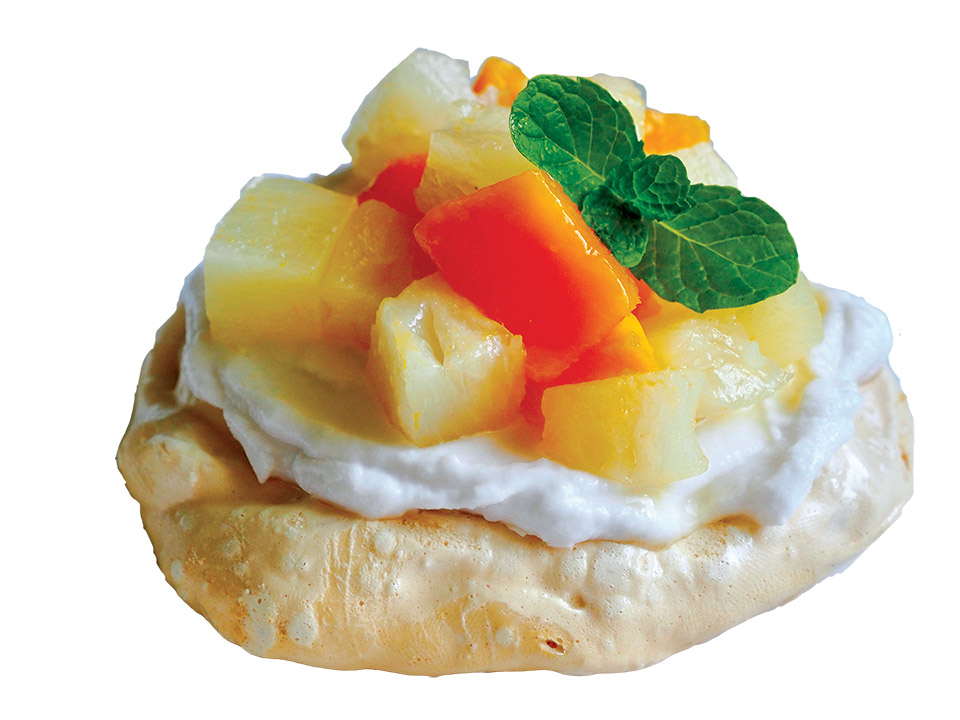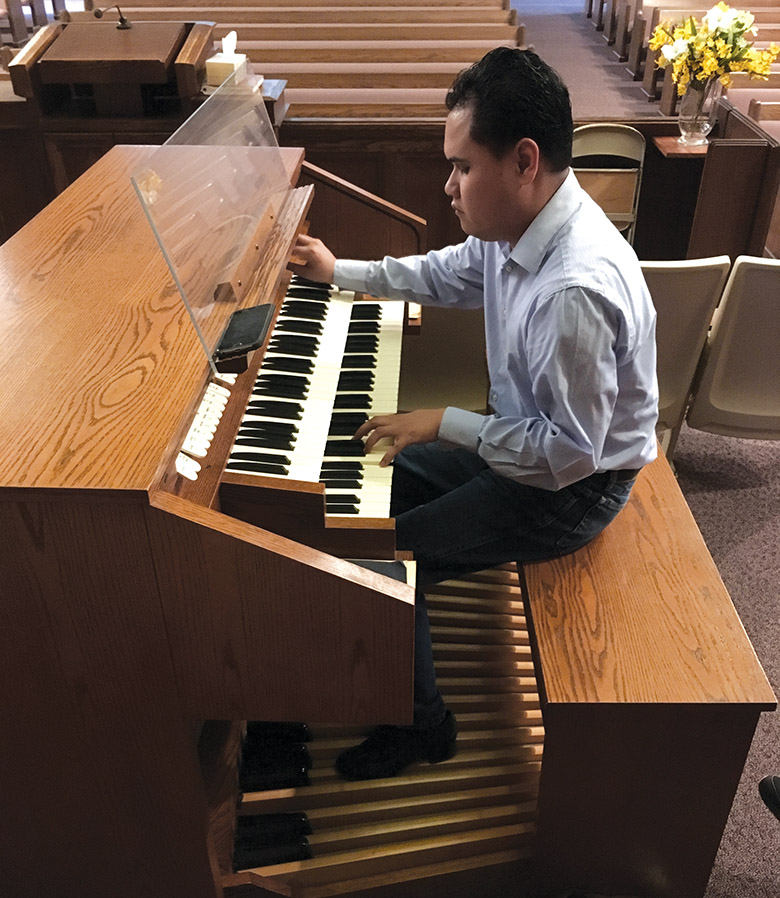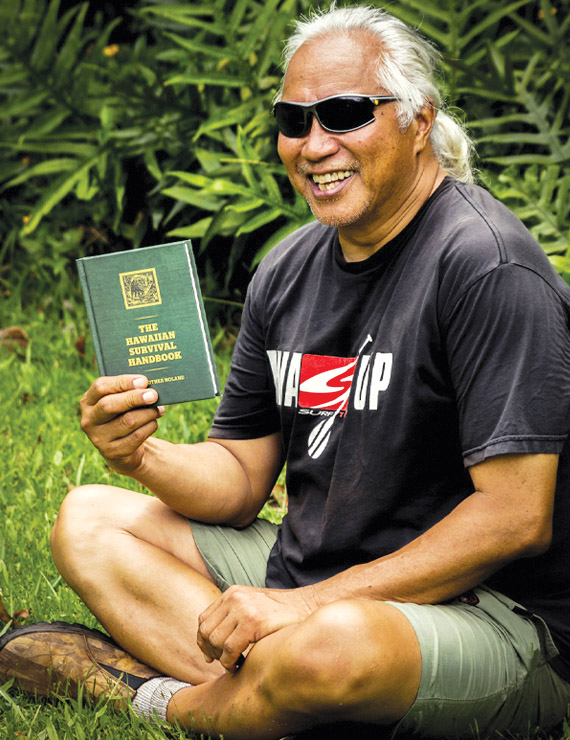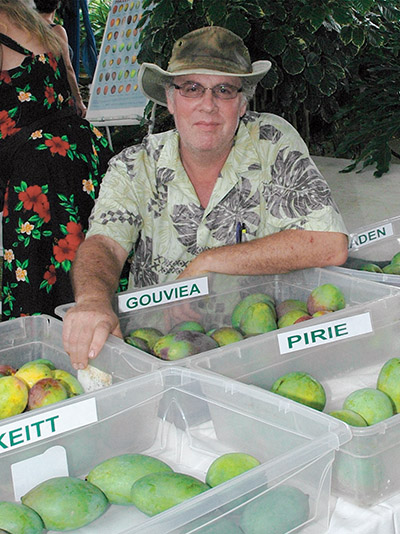
Hawaii Tropical Fruit Growers: Cultivating Successful Farmers to Feed Our Island
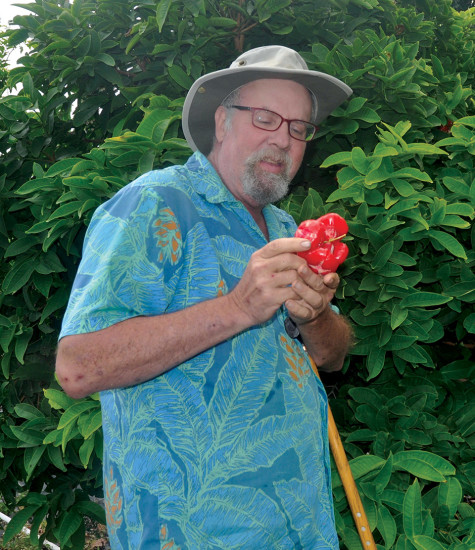
By Fern Gavelek
Growing fruit in Hawai‘i to feed our island is one thing. Growing farmers to do it successfully is another.
The Hawaii Tropical Fruit Growers (HTFG) does both. The statewide nonprofit was founded in 1989 and boasts more than 800 members with about 365 on Hawai‘i Island. It has chapters in both Hilo and Kona. The long-time executive director of HTFG is Ken Love of Kealakekua, West Hawai‘i’s official fruit guru on everything from avocado to yuzu.
Educating consumers about favorite fruits like mango, and not-so-familiar ones like ooray, is on the radar for HTFG and the organization does it through a busy schedule involving promotion, research, education, and collaboration. For fruit production, HTFG operates five repositories—with three on Hawai‘i Island—to produce and provide carefully chosen varieties of germplasm to grow more fruit.
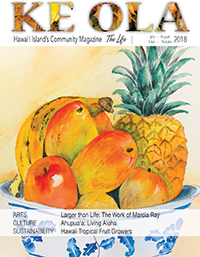
Ken says HTFG’s goal “is to make small farmers more sustainable” so they stay in the business of farming and make money.
“We teach our members about the cost of production and the importance of pricing fruit appropriately at farmers’ markets because if they are basically giving it away, like five lemons for a dollar, they aren’t going to make enough money to continue,” notes Ken, who points out it costs 27 cents to produce a lemon. “It’s not only about getting growers to understand the value of what they do, but also educating consumers on the benefits and ways to use locally grown fruit to increase its value.”
While HTFG promotes tropical fruit to consumers and collaborates with other industries, the lion’s share of its work is providing what members need to be successful in business. This is done primarily through educational opportunities and by providing affordable and viable plant material via repositories.
Fruit Promotion and Public Education
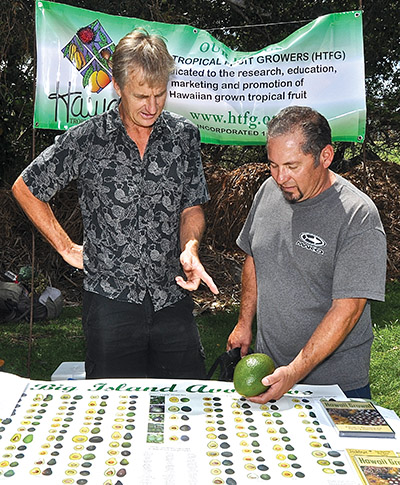
One way HTFG got the attention of shoppers was through a statewide grocer campaign to show people how to use locally grown, unusual fruits and encourage grocers to carry them. Called “New Markets for Ultra-Exotic Fruits,” the 2012–13 campaign visited four islands with 16 events to build markets for juicy rarities like bilimbi, lychee, chico, jackfruit, pummelo, tamarillos, and Surinam cherries. At each activity, growers produced the fruit and a chef gave an advertised demonstration on how to use it. Fruit was available for sale and free recipes were provided to attendees. The effort was funded by the Hawai‘i Department of Agriculture (HDOA) through a USDA competitive grant program fostering small farm sustainability.
HTFG members regularly educate the public about local fruits via displays at island festivals. For example, at Hawai‘i Island’s annual avocado festival, HTFG offers an exhibit on the many avocado varieties grown here. The organization also produces a poster on the many varieties of avocados and other fruits—banana, mango, citrus, and figs—plus the vast majority of different fruits grown in Hawai‘i.
“New-to-Hawai‘i chefs who happen to attend these festivals are amazed at the varieties of fruit we grow here,” shares Ken. “One chef thought there were only two kinds of avocados: one from Florida and one from California. We still have a lot of education to do.”
Another way HTFG educates the public is through the Hawai‘i Master Food Preservers (MFP), which teaches participants how to properly preserve locally grown fruits and veggies. “In all the other states, the MFP program is a function of the local university extension office, but in Hawai‘i, it’s part of HTFG,” notes Ken.
Research and Collaboration

Selling fruit involves working closely with the food and beverage industry and growing what chefs need—the basic tenant of Hawai‘i Regional Cuisine. In 2010 on Hawai‘i Island, HTFG partnered with the University of Hawai‘i College of Tropical Agriculture and Human Resources (CTAHR) and the Kona Kohala Chefs Association to seek the island’s best varieties of avocados. HTFG asked farmers and backyards growers to submit avocado samples for possible crop industry research and preservation.
“We were looking for a few great avocados to be evaluated by horticulturists and chefs,” Ken explains. “The idea was to get feedback and then propagate those varieties.”
Criteria for avocado evaluation included good seed-to-meat ratio, high oil content (buttery), smooth taste with no strings, appearance of skin and edible portion, plus overall flavor.
In addition, chefs were also surveyed on O‘ahu with a total sampling of 358 respondents, while an additional 1,000 consumers were queried on Hawai‘i Island, O‘ahu, and Kaua‘i at farmers’ markets and festivals. Out of the 25 avocados tested by chefs and consumers, the five top placing varieties were Kahalu‘u, Sharwil, Malama, Linda, and local Haas.
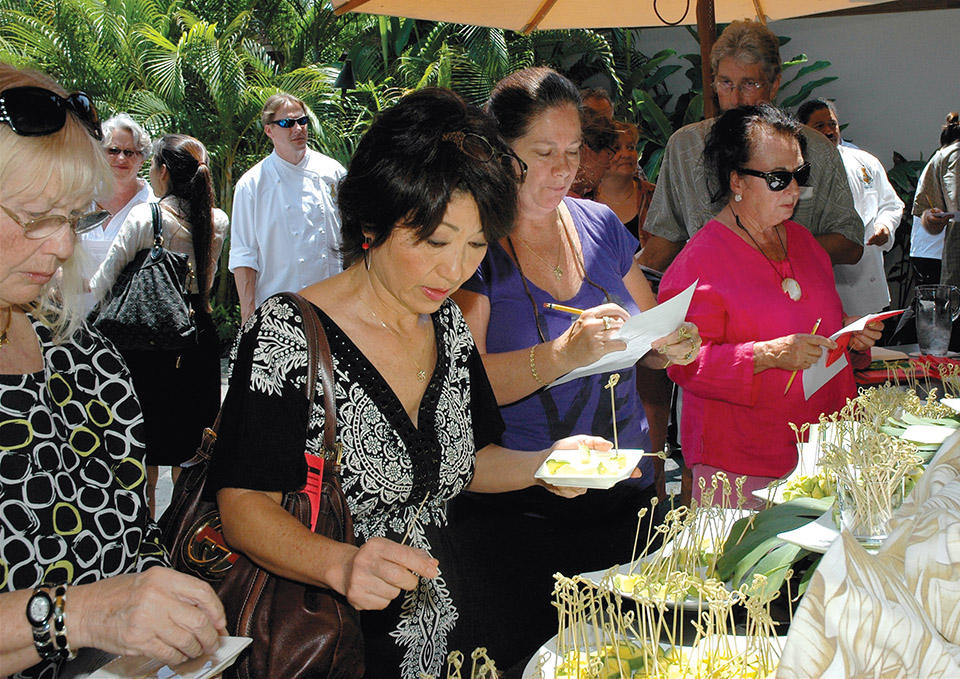
“Knowing these types will sell more easily, we grafted those types of trees or made scion (wood for grafting) available to growers,” details Ken. “We also learned that some chefs preferred other varieties and so those were propagated specifically for them.”
Ken emphasizes, “There’s no instant gratification with fruit trees.” It takes several years for a fruit tree to produce. “In HTFG, we project what the market will be like in 20 years, when our newly planted trees will be in production. We have to think about diversity as you don’t want to put all your fruit in one basket or the market will be saturated.”
HTFG Survey Has Goal to Increase Production
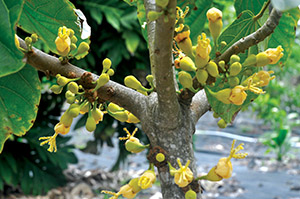
To find out what fruit, and how much, is being locally grown, HTFG conducted a 2015 survey of members and non-members that also questioned what growers need to help them successfully produce fruit. The three-month survey was funded statewide by the County of Hawai‘i’s Department of Research and Development.
“The purpose of the survey was to determine what actions to take and to fulfill grants to get fruit trees into the hands of growers to increase local production,” says Alyssa Cho, assistant researcher in sustainable farming systems with an emphasis in tropical fruit and nut production at University of Hawai‘i at Mānoa.
The survey’s 138 participants claimed a total of 42,955 fruit trees under cultivation with 88 percent growing citrus—primarily limes, lemons, oranges, and tangerines—83 percent cultivating avocado and 82 percent farming bananas. Other popular fruit in the mix included mango, papaya, and pineapple.
Top criteria used for selection of fruit trees grown on farms included the cost of the plant and time needed to produce a crop, followed by disease resistance and value for home use.
Educating Members

HTFG presents its annual conference on one island and then continues with mini-sessions that travel to four additional islands. The main conference location rotates each year among O‘ahu, Hawai‘i, Maui, and Kaua‘i. These multi-day gatherings offer access to knowledgeable agricultural experts and researchers from around the world, breakout sessions, and farm tours geared to farmers, orchard managers, educators, and proponents of sustainable agriculture. The conference sessions are open to the public. Topics cover what members need to know: the latest research on select crops, integrated pest management, cultivating techniques such as trellising and the importance of pruning, irrigation, soil culture, harvesting, marketing, foreign trade, etc. Conference presentations, along with a wealth of other helpful educational materials, are available on HTFG’s website.
The organization maintains a public group page on Facebook, Hawaii Tropical Fruit Growers, which boasts over 5,600 members. Users have to apply for membership. The page started as a members-only forum to exchange ideas and troubleshoot growing challenges.
“We opened the page to the public to spread HTFG’s mission and knowledge and help build goodwill among fruit growers worldwide,” explain Ken. Besides members benefiting from the page’s lively forum, they have made contacts with international growers in Borneo, the Philippines, Malaysia, Japan, and India who have provided growing material that is being cultivated and under quarantine at an HTFG repository.
In partnership with University of Hawai‘i, HTFG also presents workshops such as lychee air-layering, grafting, and fruit tree fertilizing.
Hawai‘i Island Plant Repositories
HTFG operates Hawai‘i Island repositories in Honomū, Hōnaunau, and Kealakekua. The newest, three-year-old Kealakekua repository sprawls across two acres of Ken’s farm and offers 300 varieties of fruit plants.
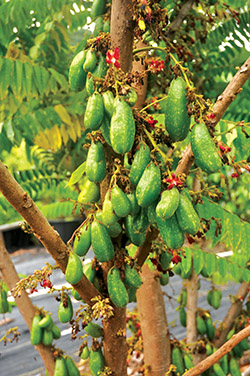
“Repository choices are based on economic potential for future markets and use in value-added products,” emphasizes Ken. “It’s about what sells to local consumers, what chefs want to use to dazzle our visitors, and what can be enjoyed out-of-hand.”
Ken says HTFG relies on the National Agricultural Statistics Service (NASS) to identify what is being imported to Hawai‘i “in the millions of pounds.” From those figures, HTFG pinpoints what members should grow to fill local demand. Those plants, like citrus, are propagated at the repository. In addition, other plants requested by members are cultivated, such as durian, bush tucker fruit like finger limes, and Davidson plums.
To determine what varieties of fruit to grow, each repository chooses cultivars that grow best in that location, are good producers and can also be potted for home use.
Since opening in Kealakekua, 13,300 plants have been in the works. They consist of planted trees in the ground, plus seedlings in pots, grafted trees, and scion for distribution. Work is done by HTFG and community volunteers.
“In a two-year period, we have already distributed 8,200 trees from the Kealakekua repository,” details Ken, who says a current HTFG repository project with HDOA is to disseminate 10,000 trees in three years.
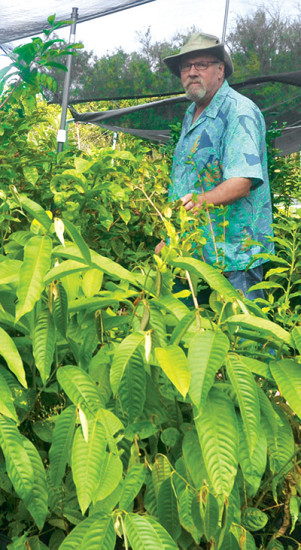
To get plant material from the Kealakekua repository, HTFG members simply request inventory, purchase, and pick up. Chapter presidents from the different islands also visit to get trees to sell at events or plant in their own repositories. Ken says plans are in the works to open a repository on Maui; the other two are on Kaua‘i and Moloka‘i. In addition, the Kealakekua repository partners with the Urban Garden Center of O‘ahu for educational activities and providing materials to propagate fruit trees via cloning, grafting, and air layering.
“Trees are also sold to the public, plus donated to schools, plant collections or Master Gardeners programs,” adds Ken.
Another way members get plant materials is through research collaborations with the USDA. About 10 years ago, HTFG members helped the USDA determine what figs grew well throughout Hawai‘i as the state is free from the fig wasp.
“Because of the introduction of fig varieties from the USDA repository in Davis, California, Hawai‘i growers are now able to grow more than 50 types of figs, where before we only grew a handful,” notes Ken.
Summing up the efforts of HTFG—whether involving research, collaboration, education, or promotion—Ken says it’s all about “offering growers choices that help them become more economically viable.”
HTFG’s Kona Chapter meets at 6pm on the third Monday of every month at the HTFG office at 81-6393 Māmalahoa Hwy. in Kealakekua. The Hilo chapter gathers every other month at various locations. Membership is $50 annually and open to the public. ❖
For more information: hawaiitropicalfruitgrowers.org
HTFG Hilo chapter: axel.kratel@gmail.com
Mahalo Kona Coast Realty – Sustainability Story Sponsor
